Celebrating with foods that make us feel good!
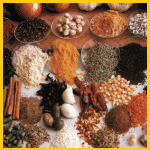 Celebrating a new baby in family gatherings is part of the joy of birth during the holiday season. Most mamas will eat whatever is in front of them during the holidays and love it, be so grateful for being cooked for, and maybe not put one and one together to why baby is fussy, both constipated, or have sleep, mood and other issues.
Celebrating a new baby in family gatherings is part of the joy of birth during the holiday season. Most mamas will eat whatever is in front of them during the holidays and love it, be so grateful for being cooked for, and maybe not put one and one together to why baby is fussy, both constipated, or have sleep, mood and other issues.
Celebration food is yummy, rich, and full of love! It contains qualities mamas crave, and they actually need. Remember, breastfeeding is nutritionally like running 10 miles a day! And digestion usually – surprisingly compromised. Holiday spices are for the most part also just what she needs – extra of. So, definitely, lean into the best sources for her with warm, oily, moist, sweet, and digestively well seasoned. For Northern Hemisphere, these are winter balancing needs too. OK, my dear Aussie students, please humor me.
All sounds easy so far – there are a lot of these qualities on the holiday table, right? Some discernments will help though. There are few early postpartum mama-baby couples who won’t
suffer from holiday menus also, even made with the most organic and lovingly prepared foods. That is, many foods carry needed tastes or qualities, but are prepared and combined such that they so easily create problems like gas, bloating, constipation, cramping even reflux.… and usually in addition, the well known heaviness, dullness. It’s not just from tryptophan, but from overloaded digestion not able to convert well into vitality and joy. I don’t believe this is worth it, especially when so fragile.
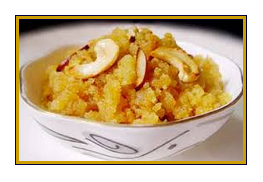
Would you like some ideas how to modify or favor traditional American holiday foods, to honor a newborn mama-baby best? Here’s a few – more than you can use – to get your juices flowing….pun intended!
Sweet taste first?
Actually, there are reasons to serve sweet taste if not dessert first. Like, keeping blood sugar and mood up while the main meal gets cooked. The sweet taste WILL get absorbed first also. And anyway. First stage of digestion is in the upper part of the stomach, part of why we immediately feel better when we start to eat. If complex, fruit, or even simple sweet foods come after the rest, it’s likely to derail the digestive process for the rest, and focus on sweet digestion and fermentation results. Then those needed for balance fats and proteins ideally included in desserts are not used right. Especially if the latter fights digestive intelligence with poor food combinations.
More on Fruits
Most fruits taken with the big holiday meal, or even with the celebration breakfast (my family always does it) means guaranteed gas, often intense, for mama and baby. Give fruits or fruit drinks at least an hour before or after, and please don’t combine with protein powders, dairy, soy, or yoghurt. But a splash of pomegranate juice in a wine glass, not chilled, with squeeze of lime and pinch of salt is nice as appertif, and papaya has special digestive properties.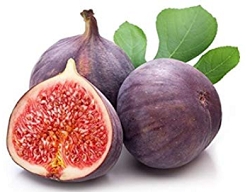
Cooked chutneys/relishes with lots of spice may work, no guarantee. That little crock pot ($12-15 at Walgreens?) is so handy for her – put dried fruits, your choice, in with cinnamon stick and few cloves and some water overnight – SO easy for that 5 am feeding appetite which should be there or she needs AyurDoula’s guidance. It nourishes rasa, rakta and mamsa dhatus (plasma, blood and muscle!) and helps the bowels move easily .
Between meals, an hour or more before/after, she will likely love a hot cup of mulled grape juice (high iron!) or cider. Grape nourishes the liver and blood. Make it easy. Keep a carafe or thermos of spiced tea or cider handy to share or not. For the mulling spices – A no caffeine spice tea/chai mix makes it easy, or just use a tsp or so of grated ginger and pinch clove. Or half tsp dried ginger. Her fennel and fenugreek can go in there – doesn’t take much. Anise actually is more warming than fennel, and can be substituted in winter. Clove multiplies the vitamin C in stewed apple and pear, by the way, but these two fruits make pectin when cooked, slowing the bowel. That’s a common discomfort already in the first 2 or more weeks after birth, so wait a bit.
Her Just Desserts
Yes, she works hard and deserves, needs extra treats, if they agree with mama and baby. Oh there’s plenty choices, and here just tip of the berg. Holidays tend to be heavy on sweets, and are we here. Don’t worry, there are other food types discussed below! You might be interested to know though, I heard a yogi talk about the benefit of sugar, eaten during group celebrations, of dissolving the myelin sheath, so it could be reformed with more happiness! The “tarpaka kapha” involved is a kapha byproduct, i.e., from earth and water ’tis made – the key structural components. Sweet taste is made from earth and water,.
Anyway, for the first couple weeks after birth our innards are very tender and we are extra sensitive. So – mushy, warm, soupy or pudding format and warm smoothies are best. Use the key principles of – WARM, OILY, SWEET, (usually), EASY TO DIGEST, MOIST, PUNGENT, with simple food combining, not rough and dry, and with YUMMY in mind. For most, a big YES for carb rich, combined with good fats, and protein sources like milk or almond milk all help stabilize her energy.
The first three days, a nourishing Raab is used traditionally (this and many recipes in the cookbook, digital download for $30) is a heavenly warm smoothie benefiting mama – and babe. Avoid if possible the egg/dairy combos in pies, cakes and eggnog though. Our cashew nog in the cookbook would be lovely maybe after first 10 days. Nuts should be well soaked and blended with spices and sweet! Both recipes – serve hot.
A well spiced yam pie offers some progesterone support along with such soothing and rejuvenative nutrition. If you have recipes for carrot, winter squash, sweet potato all can be suitable too. Thicken with a little rice or mung type flour instead of egg, use those important spices, ok full cream or coconut milk (no ½ and ½, food combining and satisfaction both suffer with it), and maybe an iron rich sweetener like succanat or coconut sugar (not fruit, and don’t cook honey!) – now we are talking! Simple puddings after 1 week, such a pie maybe after 2-3 weeks, is best.
The first 2 weeks, lonnnnng cooked authentic rice pudding, or for lighter fare, tapioca pudding (neither need egg!), with extra fat in it along with strong dose of pepper, ginger, clove, and cardamom. Use ideally, ghee for the fat, or add pinches of cayenne to warm coconut oil’s energetic coldness, or almond or sunflower oil for lighter, or even roasted sesame oil for kaphas. Did I say ghee? Add some more of one of them for her at the table. Moms do really enjoy the Panchakola ghee Ayurdoulas are taught to provide for first taste and meals after birth, and it is so easy to use on her food for the extra agni/digestive support needed. Unless of course liver/gall bladder condition dictates not.
Do unleavened butter cookies and shortbread with candied ginger/cardamom sound good? After 2 weeks or so, if bowels are moving well. The cardamom shortbread is one of our client favorites. Pfefferneuse – aren’t they pepper spiced? Try a recipe w/o eggs. Unleavened ginger treats, even a dish of candied ginger instead of ribbon candy, is great idea.
Easy on the chocolate, but how about a few Candied pecans? My best ever are dipped in syrup made from melted dark jaggery (Indian sugar; the really dark stuff is extra high iron though not common in Indian stores). Use a little water only to heat and dissolve with a cinnamon stick, and maybe add a little dark chocolate. Well, maybe 2 or 3 pecans that way is ok for now.
Chocolate does interfere with metabolism, for all dark chocolate’s great benefits, and baby easily can get rashy. Save room for some of the savory rosemary or curry spiced toasted almonds too. Pecan pie with egg is heavy though. The fruitcake will really appeal too, though watch for heaviness. Mom served it with such a yummy buttery brandy sauce…. we won’t have it this year, she is 95 now and I won’t be making it. Anyway, too many of any nuts can congest delicate liver and digestion, and constipate, but just a few are such good sattvic, serontonin enhancing nutrition (almonds especially)!
Mother’s Almond Herbal Snacks are exciting to more than Mama, a great party special. They include saffron, nutmeg, cardamom, ginger, almonds and coconut as well as more exotic ingredients. This recipe and Panchakola ghee are not in the cookbook – ask your local AyurDoula for some!
Sweet making for creative cooks and herbal esoterics
We have been having so much fun with an herb called Anantamool. Making yummy multi-herbal-date-raisin-nut-ghee-and dark (ie iron rich) sugar treats, definitely same color as chocolate! provides nourishing easy to take medicinal snacks. Inspired by Nomi Gallo, who is one of our and the Ayurvedic Institute’s faculty when she assisted during Dr. Lad’s Herbology for Reproductive Health, these are such a good absorption delivery method for rejuvenative herbals, and defiintely makes you think chocolate! OK, some of us anyway.
The fat in the ghee, gentle bitter in herbs, hormone regulating and sweet nutrition is similarly satisfying w/o disturbing baby. Anantamool (American Sasparilla) is great for liver and blood, endocrine system, pitta reducing, magnesium rich, benefitting skin health and female hormonals w/o being estrogenic. It is a rasayana (rejuvenative tonic) . And how yummy Anantamool tastes!
This year in Whole Foods, I’ve seen sliced gourmet wedges from big wheels of fig and walnut, or date and almond “cake”. Just two ingredients, best the label tells. I want instructions how to make.
Even better for early postpartum weeks, we can grind clarified butter-roasted edible gum acacia, gently warm the other ingredients with spices in MORE ghee, then press all together. This sliceable fruitcake w/o flour and eggs strengthens connective tissues. A little goes a long way for snack, with cup of sweetwater lactation tea (add ginger for the winter!)
This “fruitcake” is great also for strength, lactation, iron building, and her naturally active sweet taste. Press in a pan and slice, or roll in a ball, whatever, kids love it too. The spice is more than nice, remember, and the ghee more than wheeee-eat-losta-yummy-butterfat!
The Big Fat Story, part 1
Clarified butter is especially good at so many things for mama-baby, like hormones, bones, good cholesterol, lubricates the bowel and smaller body channels, it also helps deliver nutrients and remove wastes – like those deep tissue hard to remove petrochemical toxins and metals that are most risky. OK, it won’t help much with the latter around holiday foods, but could at other times.
We DO need extra fats after birth, and even with that extra baby weight we want to loose, we need the right fats to help loose it. Here’s a snippet of that discussion: Research shows good cholesterols are needed for female hormones, protecting from bone loss, (ref 4)and hormones need balance in order to loose that weight.(ref 5) Stress weight comes off easier too. And Vitamin D3 (not 2), plays an important role here. Grass fed cow milk, cream and cultured butter made into ghee – are pricey, and worth it for the Vit D3 and related factors here (ref 1). Vit D acts like a hormone itself, for mood, mineral absorption, immune, blood sugar balance and more at optimal levels. Advised in winter – take 4-5,000 IU/day, not 600 (ref 1).
Stuffing
Grains, rather than bread, is best, and after the first week or two to avoid constipation complication. Try stuffing a pumpkin that is partly shaved and bake together; use the pumpkin in a soup. Give mama the bottom, really moist and mushy part. If using wild rice for a gourmet touch, since it is kinda rough on tender innards, use just a little, presoaked overnight and long cooked before adding the other. Red, brown, any rice can be used if cooked well – overnight crock pot or pressure cooker makes it very easy. Yes roasted chestnuts are lovelies, but easy on the sage (drying to milk production in larger amounts) For those who use a broth for liquid, it is better not to use from a box due to the lack of life force. I prefer onion sauted with herbs and spices for flavoring.
Non-vegetarians can use fresh poultry broth. Made from neck and foot bones slow cooked overnight to gain all the fats and marrow, and perhaps with giblets will be very healthful and digestible. Using fresh herbs like thyme, oregano, parseley ,maybe some fresh fennel instead of celery if you can get it. In any case, very well cooked, onion and celery are usually ok. Well cooked onion will enhance digestion, like garlic.
Breakfast
Traditional oatmeal needs dressing up and mushing out. Our First Day’s Rice Pudding idea (any kind of rice except wild) goes over well, but PLEASE NOTE! that recipe should say ½ cup sugar, not 2! This is not just a high carb diet. The 2-3 Tbs of ghee served with cereals and other foods in early days for the lucky (most) qualifying mamas, does cleansing, lubricates, and gives long burning, stabilizing fuel long after the carbs have come and gone. It can be made with various grains especially rices, oatmeal, later wheat/kamut/spelt for heartier fare, or barley, quinoa or millet for kaphas and lighter fare. Millets are preferred for diabetics, with more sweet and favored holiday spices like the anises, fennel, cinnamon, clove, cardamom cooked whole, overnight – no sugar needed, but the fats are – toasted sesame or sesame is good for high kapha. Even citrus zest is lovely for mamas. The first day’s rice pudding serves 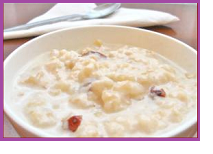 and tastes prettier with spiced ghee, rather than cooking brown sugar and spices for hours into it.
and tastes prettier with spiced ghee, rather than cooking brown sugar and spices for hours into it.
Mothers are advised all the hot boiled milk they like; cow’s cream top not skim for many is best. Adjustment to genetic or acquired difficulties with dairy milk is sometimes balanced with the preparation and spicing methods in cookbook, sometimes with goat, and sometimes nut or grain mylks are needed. Due to the low prana of boxed mylks, freshly made is indicated. My preference here to balance the amino acid profile, is first gently saute a Tbs of amaranth or quinoa in clarified butter or another stable fat which nourishes all 7 dhatus (tissues). Sesame does, coconut does not, FYI.ii Add the almond milk slowly to cook well and enjoy, seasoned with some ginger or your choice.
Instead of heavy Hollandaise (which will sound so good because of the creaminess, protein and sour taste) new AyurDoulas are learning how to use generous seasonings of herbs, ginger, garlic and onion, with coconut and generous fats (yup, that craving is real) for really yummy saucing. The avocado is still fine. If they took Anupama Vaidya’s class, they have a great recipe! After a few days, for mothers craving egg, serving them in this kind of sauce/soup, gently poached in the sauce. I sometimes serve a bowl of moist and well oiled oatmeal with an egg yolk, salt and generous pepper (avoid milk with this meal).
Main and protein dishes
For the first 3-10 days, there is not much distinction for main, side, etc. Soups are really a good idea, puddings, a very thin mung broth well seasoned can get thicker with the mung (or red lentil, muth or urad lentil) puree, and include that mother’s garlic chutney if you can on the menu after 3 days. Hot milk tonic freshly made will be so soothing. Just keep it simple and easy to digest; ideas above and in the cookbook will make a big difference.
Unless she really wants kitchari on Christmas, Baked yam with lots of pepper and ghee (and Aparna’s mother’s garlic chutney!), and suitably thickness of grain gruels well oiled and spiced are a good idea. For late postpartum window, we offer recipes for non-tomato based lasagne or pasta sauces with fresh/ricotta or panir cheese, and seasoned panir “steaks”. Dr. Shrestha’s Sprouted Mung Pate recipe works for me and people love it, but some have trouble getting it to come out right. Recipe testers?
Note Yummy sweet and savory dips and spreads – These are best about 3+ weeks postpartum and will be loved for long time to come: Non-fermented Seed Cheese, Flaxed cottage cheese sauce, taratoor sauce with tahini, Guacomole, flaxed/honey/nut butter (dip an unleavened non-corn tortilla/chapatti) or even a holiday saffron-cream cheese honey/flax oil and lemon zest with cardamom for dipping moist dates! PLEASE, avoid it possible chilled foods and drinks, or dips from a plastic store bought item like hummous, sour cream, or bean. They can be quite troublesome.
Non Vegetarians
Ayurveda is not vegetarian; there are reasons to be, and anything might serve as medicine though the field is tighter when we are very delicate. For non-vegetarians wanting more the first few days, overnight cooked poultry broth w/o salt for 1-3 days, then adding a little of the long cooked meat (not much!) , is best the first week. Season well. Gradually after that, thicker. Although lower in prana and vibration, gas and constipation are not an issue when the broth of the cracked bones prepared with citrus to extract marrow is long cooked. Such options are sometimes advised or craved, and are very iron and nervous system nourishing. Poultry can also be added like egg to soupy spiced sauce instead, for same recipe as above. Start slowly, and again, cook long and gently if you can.
As in the Jewish tradition, avoiding meat and fish, dairy or egg when combined together is general rule and especially important to choose one protein type at this time. Ok they mix dairy and egg, Ayurveda does not. Red meats are best avoided, along with fish and more solid portions of any meats will aggravate towards constipation, I see it all the time. A long cooked broth freshly served is blood building but even then, red meats can increase hot flashes and tendency to temper in mama and baby.
Vegetables….

Sweet roots, like Beets! After about 10 days, well cooked, the color and nutrition is great of well cooked dishes. A little fresh dill and generous roasted garlic – or onion – along with some
of the many spices like ginger or anise which beet agrees with gives many options. I have a favorite puree of beet soup with winter squash, generous ginger, ghee and white cacao butter (not same at all as white chocolate) a little fresh fennel, and other secrets. The color is STUNNING! Creamed veggies can be made with coconut milk; really avoid milk sauces and soups. Use extra spice! And satisfy that craving for creamy with more fats, especially clarified butter or even butter.
Before 10 days be careful; for some beet increases elimination and can increase bleeding. Carrots can be used after 2-3 days, in many ways. BTW – we get more vitamin A from well cooked carrot, and in the top ¼ inch, so trim them with respect!
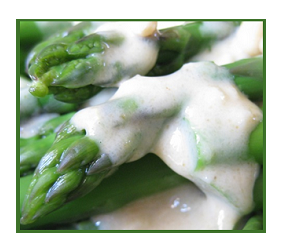 Sometimes we wait for celebration to use asparagus, being more expensive. It is one of the best early postpartum veggies. Or try this roasted fennel recipe: Trim greens and quarter lengthwise to the root. Using GENEROUS ghee in a heavy bottomed pan, lay the cut edges in the hot ghee. Sprinkle a tsp of anise seeds, some salt, and generous black pepper. When seared on one side, turn and do same on other cut edge. Then lower heat and cover to cook about ½ hour or until the fennel is really tender, but still in nice presenting quarters. Serve hot, with the extra fat. The juiciness of this vegetable will create it’s own steamy and a little sauce. Be really slow to introduce dark leafy veggies, as we have discussed in other newsletters.
Sometimes we wait for celebration to use asparagus, being more expensive. It is one of the best early postpartum veggies. Or try this roasted fennel recipe: Trim greens and quarter lengthwise to the root. Using GENEROUS ghee in a heavy bottomed pan, lay the cut edges in the hot ghee. Sprinkle a tsp of anise seeds, some salt, and generous black pepper. When seared on one side, turn and do same on other cut edge. Then lower heat and cover to cook about ½ hour or until the fennel is really tender, but still in nice presenting quarters. Serve hot, with the extra fat. The juiciness of this vegetable will create it’s own steamy and a little sauce. Be really slow to introduce dark leafy veggies, as we have discussed in other newsletters.
Salads? Oh be very careful here.
Sorry ladies, but the truth is, tossed green or traditional raw veggies for dipping are guaranteed gas on tender tummies and the habit will build easily towards colic over time. Try these ideas instead:
- Warm steamed veggies with lime vinagrette – like asparagus, or carrot, beet, or even zuchhini though that more easily may be gas producing.
- Emerald Chutney – these are transition recipe variations in your cookbook. Not for early postpartum, although you can add some to soupls the last few minutes for the quick cooking. And at 5-8 weeks, mamas love these easier than regular salad on digestion, and really full of prana and the health benefits of herbs like parseley (think warm, kidneys and B vitamins), cilantro (think cooling,
Leftovers and Frozen foods? Oh oh…..
Risky. Honestly. Main dishes, veggies and grains especially, served the next day, from freezer, or combined with something new for a new dish, are pretty sure to cause more intense tummy problems. And then she may think she has to take enzymes. Then she has expensive pee and poo, you know? Those dry caps and tablets don’t handle very well. However – back to the inevitable. Ie how many will eat of the tasty leftovers anyway …. This is helpful for digestive support, and so easy: Recipe for Fresh Ginger Pickle: Make a little (like ½ cup max) jar full of thinly sliced ginger. (Scrape any rough skin and dirt to peel), Add about ½ tsp salt, and juicy squeezings of a lime (way better postpartum than any other citrus). Take a slice before eating, and while and after if tummy is really sensitive. Keeps in fridge for a few days.
The Spice of LIfe
Isn’t it interesting how many of the “Christmas” spices, are important in the postpartum time? There is good reason. Not only improving appetite (ie, deliciousness!), they are so important for improving digestion, absorption, and elimination. Our AHHHHH! For life, is intimately tied to our digestive power – we call it “agni” – our natural digestive enzymes.
The love hormone, oxytocin, thrives on holiday gatherings- any flow of heart – and I’m sure it must help digestion too. We can do a lot to help things along though. A healthy physical digestion makes us more clearly and simply alert, perceptive, and responsive to the flow of love and life all around us. Step by step, when a mother’s community can cultivate understanding of the influences and inner workings of our body, mind and spiri, the layers of Life integrate and bloom healthy and happy.
Agni in the duodenum and it’s source enzymes are related strongly (90% of our serotonin is found there, and serves many functions including neurotrasmitters for contentment). Our culture’s pioneer based food traditions need a little cleanup, according to Ayurveda’s dietary wisdom. It is no wonder so many have mood issues, with conditions especially of the duodenum. Ayurvedic Medicine considers the duodenum a separate organ, it’s role is so significant. (ref 6). Gluten “allergy”, asthma, mood issues, constipation and diarrhea, diabetes, milk “allergy”, many other issues show their root in what is happening in these first few inches of the small intestine as food leaves the stomach. This is because such important agni activity happens there – or doesn’t, well enough.
Accumulated poor quality digestion adds up for baby. I’m sure you DON’T want to experience, or contribute to colic. Please don’t be afraid to mother the mothers, at least offer to help in this way.
OK, I’m going dancing!
Wishing you such a warm and wonderful holiday season, as the days begin to lengthen and we take time to reflect on our lives, our loves, and our light.
Ysha Bhu
_________________________________________
I Weston Price, DDS; Nutrition and Physical Degeneration, pp 386-389. Price-Pottenger Nutrition Foundation, (1939-) 2009.
ii John Douillard, DC and Ayurvedic Physician; cites multiple references at http://lifespa.com/?s=vitamin+d
iii Vasant Lad, MASc; Textbook of Ayurveda, General Principles of Management and Treatment, vol 3, pg 394. The Ayurvedic Press, 2012.
iv Vaidya, Bharat, MD (India), Ayurvedic Physician; Dhatu and Strotansi, and Sree Rog and Madhav Nidana advanced seminars in Ayurveda; notes from Colorado/webinars, November 2013.
v Carolyn Mein, Different Bodies, Different Diets. Regan Books/Harper Collins, 2001 and Seminar discussion, Denver, 1998.
